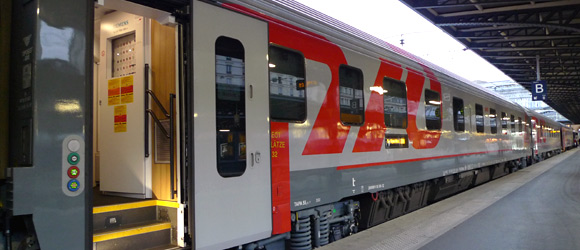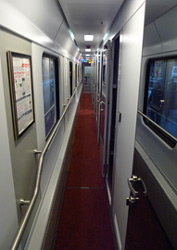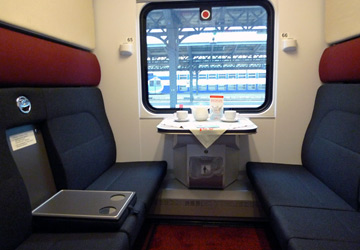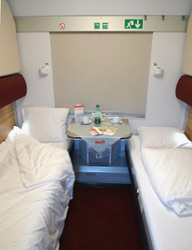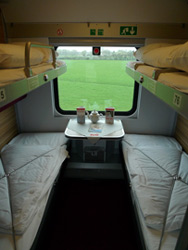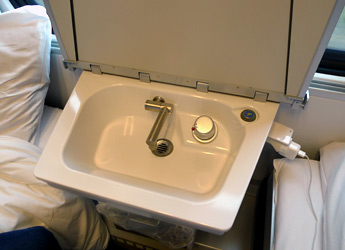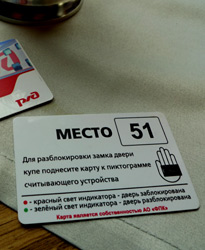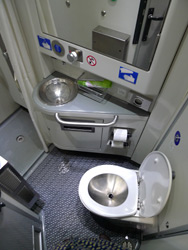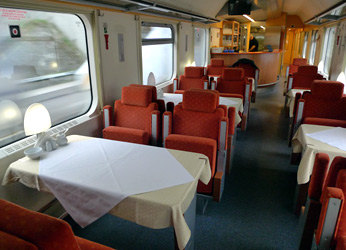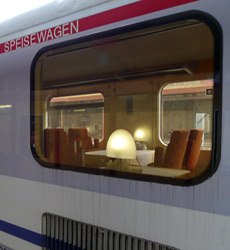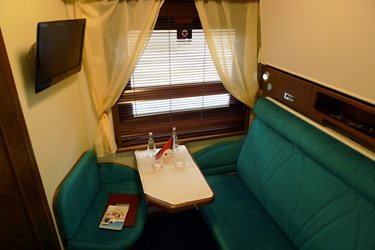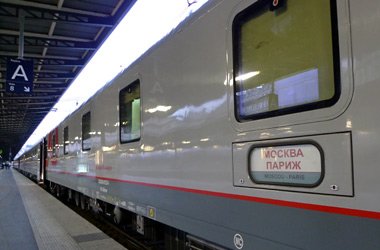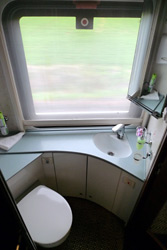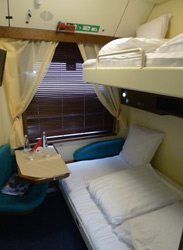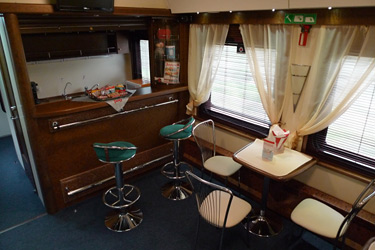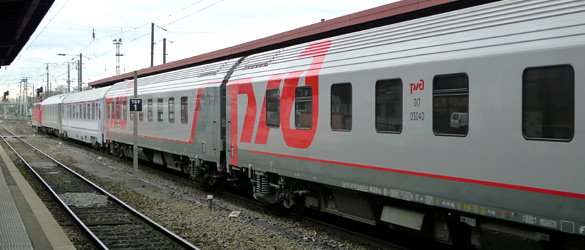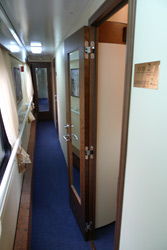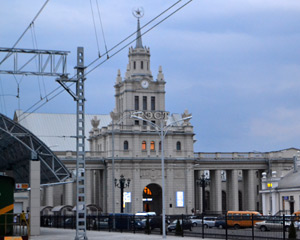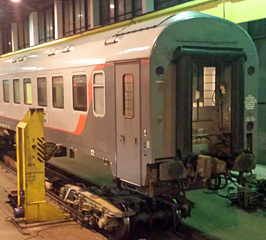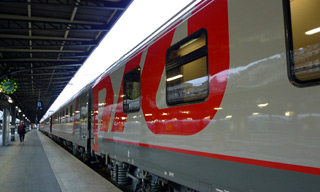 |
|
|
The Paris-Moscow Express at Paris. |
|
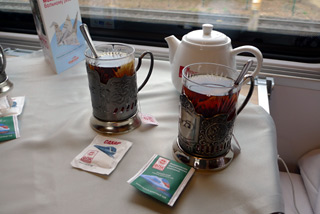 |
|
|
Your sleeper attendant can serve delicious Russian tea for a few eurocents. |
|
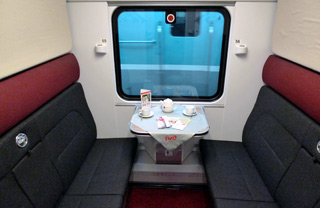 |
|
|
A 2 or 4-berth sleeper in day mode. |
All aboard the Paris-Moscow Express
It's the classiest way to travel from London or Paris to Russia. Russian Railways (RZD) operate an entire train from Paris Gare de l'Est to Moscow once a week all year round, with comfortable 2 & 4 berth regular sleeping cars, luxurious 1 & 2 bed VIP deluxe sleeping-cars and a restaurant car. You can book it for the whole journey or even for intermediate journeys such as Paris to Berlin or Berlin to Moscow. The train runs for some 3,483 km or about 2,164 miles from Paris to Moscow, making it the second longest direct passenger train in Europe - the longest being an identical train which links Moscow with Nice every week. These trains are jacked up at Brest to have their wheelsets changed from European standard track gauge to Russian gauge, an interesting experience. IMPORTANT: Read this update about travel to Russia through Belarus.
IMPORTANT UPDATE: ALL TRAINS TO/FROM RUSSIA SUSPENDED. All trains to/from Russia were suspended in 2020 due to Covid-19 & now remain suspended due to sanctions.
Timetable eastbound
Always check times for your date of travel as they can vary. You can book it between any two stations.
* = Arrives Minsk 02:05, Moscow 10:58 from 29 March to 24 October as Russia has no Daylight Saving Time.
** = Leaves Moscow 18:17, Minsk 03:13 to 28 March & after 24 October as Russia has no Daylight Saving Time.
Timetable westbound
How much does it cost?
Returns are twice the one-way fare. Children under 12 half price. Interrail & Eurail passes are not valid on the Paris-Moscow Express at all.
Berths are sold individually, prices are for one person in one bed. So if you book (say) one 2nd class ticket you will travel in a 4-bed sleeper sharing with three other passengers of the same sex. There is no need to pay for sole occupancy unless you want to!
You can buy tickets for any stage of the journey, for example Paris to Berlin, Paris to Warsaw, or Berlin to Moscow, see www.rzd.ru for tickets & prices.
There's more detailed fare information at www.rzd.ru including discounts for honeymoons & a week either side of your birthday, with details of the generous luggage allowances and how to take pets. Switch it to English by clicking the UK flag, click Passengers top left then look for International routes at lower left.
Additional Berlin-Moscow trains: Although the Paris-Moscow train reduces to once a week in December, from 17 December 2016 there will also be a twice-weekly sleeper train Berlin-Moscow, for details see the Trains from Berlin or Trains from Moscow pages.
How to buy tickets
-
There are several ways to book tickets on this train, each with pros & cons. I recommend browsing these 5 methods to see which is best for you. Feedback would be appreciated if you book this train, however you book.
-
Method 1, direct from the Russian Railways website www.rzd.ru with print-your-own e-tickets.
This is a bit fiddly, but it does work as long as it accepts your payment card at the end. It's normally the cheapest way to buy tickets as there are no added fees or mark-up.
Anyone from any country can use www.rzd.ru with print-at-home tickets and prices shown in rubles. It normally accepts overseas payment cards (it accepts mine), but is sometimes fussy with non-Russian cards, give it a try and see if it accepts yours. RZD.ru allegedly won't accept some US-issued credit cards, if your card is rejected simply use Real Russia instead as in Method 2 below.
On rzd.ru, 2-cl = 2/4 = 2nd class 4-berth = one bed in a shared 4-bed sleeper. 1-cl = 1/2 = 1st class 2-berth = one bed in a shared 2-bed sleeper. 1-cl 1/1 = 1st class 1-berth = sole occupancy of a 1st class 2-bed sleeper. De Luxe = VIP sleeper with shower & toilet, which is always sole occupancy whether you book one person or two. You even get a chance to select a specific berth or berths.
-
Method 2, book with Real Russia: This is easy, in plain English with UK-based after-sales service and all overseas payment cards accepted no problem. Just accept that you'll be paying a higher fare as it includes an agency mark-up over the Russian Railways price.
To book, use the Real Russia booking form at top right on the Train Travel in Russia page. Click 'advanced search - type city name' and entering Paris in France to Moscow in Russia. Real Russia connects to the Russian Railways ticketing system which holds all the berths and accommodation types. You can be emailed a print-at-home e-ticket, wherever you live.
-
Method 3: You can sometimes book the Paris-Moscow train online at www.raileurope.com in plain English with good UK-based after-sales service and no payment card problems. If it finds this train, it's the easiest way to book, at close to the Russian Railways price with just a small booking fee.
Booking tips: Booking usually opens 90 days before departure, sometimes less. Obviously, make sure you're searching on a day of the week when the direct train operates. Sleepers 'with shower' means you are selecting the luxury VIP deluxe sleeper with toilet & shower. Update: Check fare conditions carefully - do not buy from Raileurope.com if it says Birthday fare, unless it's your birthday +/-7 days from departure date.
-
Method 4: You can often book this train at the French Railways website www.sncf-connect.com with tickets collected from any French station if your journey starts in Paris, or sent to address in your home country if it doesn't. Again, if this doesn't work, try another method.
Visas...
-
Don't forget to arrange both your Russian visa and Belarus transit visa. The train enters Belarus at Brest, where Russian visas are also checked. You'll find the low-down on how to get Russian & Belarus visas here.
-
IMPORTANT: Read this important update about travel to Russia through Belarus.
What's the train like?
Regular sleepers: 1st class 2-berth, 2nd class 4-berth
The train has classy modern air-conditioned sleeping-cars built by Siemens in Austria in 2014. Each car has eight 4-berth compartments, each compartment has a washbasin and two power sockets for laptops & mobiles. Although all compartments have four beds (two lower & two upper berths), some cars on the train are designated as 1st class 2-berth with only the two lower beds in use, others are designated as 2nd class 4-berth with all four beds in use. The cars are carpeted, quiet and extremely smooth-riding, a pleasure to travel in. A sleeper attendant (provodnik or provodnitsa) travels with each car and can serve excellent Russian tea for a few eurocents when required. There's even a good hot shower in one of the toilets at the end of the corridor, but bring your own towels. See panorama photo inside a 4-berth sleeper. Identical sleeping-cars operate from Moscow to Vienna, Prague & Warsaw.
Restaurant car
A Polish restaurant car staffed by WARS, the Polish Railways dining- and sleeping-car service, is attached between Paris and Warsaw. A Russian dining-car is attached between Brest (on the Poland/Belarus border) and Moscow. By western standards it's not expensive. For breakfast, freshly-cooked scrambled egg with ham & salad costs €6, a side order of smoked salmon €4. For dinner, goulash soup costs €5, chicken breast stuffed with bacon and cheese served with potatoes and salad costs €14. The menu is written in Russian and English. Tip: Eastbound from Paris to Moscow, the Polish restaurant car is detached at Warsaw, so it stops serving lunch quite early. Take some provisions for that afternoon, as the Russian restaurant car attached at Brest doesn't start serving dinner until after 22:00.
VIP deluxe sleepers
The train also features several VIP luxury sleeping-cars, expensive and no doubt aimed at Russian oligarchs. These modern air-conditioned cars feature just 4 compartments each with a sofa which converts to an extra wide lower berth by night, an upper berth folds out from the wall, there's an en suite shower & toilet with soap, towels & complimentary amenities kit, and the compartment also has a CD player & flat-screen TV. Each sleeping-car has a small bar-lounge area at one end. If you travel VIP class, a hot breakfast in the restaurant car is included.
A brief history of the Paris-Moscow Express
-
Before World War 2, the Wagons-Lits Company ran a train called the Nord Express. It conveyed through sleeping-cars from Paris to various destinations including one from Paris to Riga, with connections to St Petersburg and Moscow. A change of train was necessary to reach Russia because Russian track gauge is 5', slightly wider than European standard gauge which is 4' 8.5".
-
The Soviet Railways (SZD) started a direct through sleeping-car service between Paris and Moscow in the 1960s, using dark-green sleeping-cars with wood-veneer interiors and frilly net curtains, complete with the hammer and sickle badge between the centre windows. Usually the service consisted of just one or sometimes two through sleeping-cars, attached to other trains and cars for each part of the route. The cars were jacked up at Brest to have their bogies (wheelsets) changed to accommodate the difference between standard gauge & Russian gauge. Indeed, SZD ran direct sleeping-cars between many European cities and Moscow, including Stockholm to Moscow once a week, Hoek van Holland (for London) to Moscow daily in summer or three times a week in winter, Oostende and Brussels to Moscow to a similar schedule and even (for a while) Madrid to Moscow. The latter was the only European passenger service ever to have its bogies changed not once but twice, from Iberian gauge (5' 6") to standard gauge (4' 8.5") at the Spanish/French border and from standard gauge to Russian gauge (5') at the Russian border. The sleepers were often used by Russian diplomats - when the Nord West Express collided with a Dutch local train in 1982, six Russian envoys refused to leave the train until they were collected by car from the Russian embassy at Den Haag. After the fall of communism, these SZD through sleeping-cars were discontinued one by one, and the Paris-Moscow service ended in 1994.
-
Aimed at newly-mobile Russian tourists rather than diplomats, Russian Railways (RZD) reintroduced a direct Paris-Moscow sleeping-car in 2007, attached to the Paris-Berlin City Night Line sleeper train as far as Berlin and then to the Moskva Express from Berlin to Moscow. This was such a success that in 2011, RZD decided to run an entire train between Paris and Moscow, to a fast day-night-day schedule. It initially ran 3 times a week in winter, 5 times a week in summer, but the fall of the ruble and a significant drop in the number of Russian visitors to the West made them cut it back to once a week in winter, twice a week in summer, as from April 2015. On the plus side, 2015 also saw the introduction of the excellent new Austrian-built sleeping-cars, with more space per passenger and a shower at the end of the corridor.
-
In June 2015 the Paris-Moscow Express switched to its current night-day-night schedule, which is more time-effective, allows same-day connections to and from London, and provides a convenient overnight train between Paris, Berlin and Warsaw, replacing (at least once a week) the now-discontinued Paris-Berlin City Night Line train. RZD hopes to pick up many extra passengers this way, even those not travelling to Russia.
-
The train is supposed to be called the Trans-European Express, but I have yet to see that name used anywhere on the Russian Railways website or in or on the train itself.
Video guide: Paris-Moscow Express


